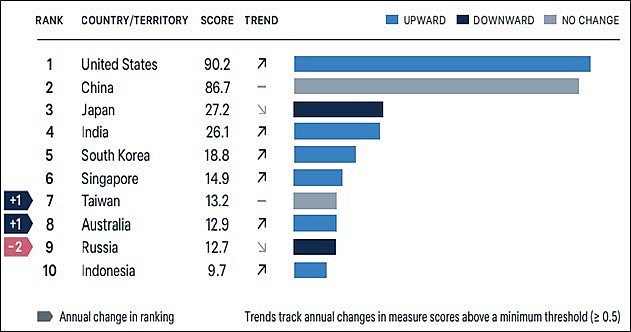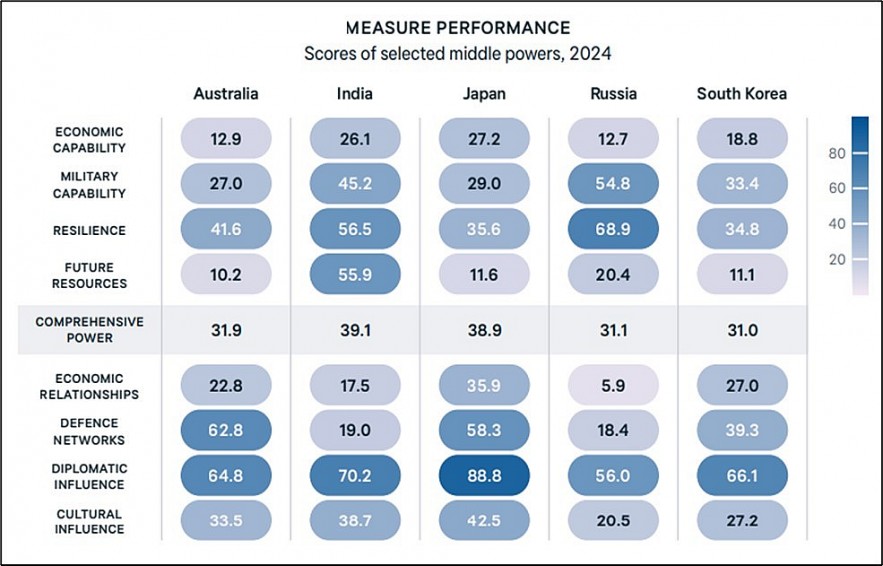India’s rise as a global power has reached a significant milestone as it surpasses Japan to secure the third position in the prestigious Asia Power Index, marking a pivotal moment in its ascent on the world stage. This development highlights a shift in the power dynamics within the Asia-Pacific region, reflecting India’s growing economic strength, diplomatic prowess, and strategic influence in the Indo-Pacific.
The Rise of India: Losers and Gainers
 |
The Asia Power Index, an annual evaluation initiated by the Lowy Institute in 2018, has established itself as the benchmark for assessing power dynamics in the Asia-Pacific. The index analyzes 27 countries across eight thematic metrics, utilizing 131 distinct indicators. These indicators are categorized into two groups: resource-based determinants and influence-based determinants.
Measuring National Power: The Multifaceted Approach
Resource-Based Determinants:
- Economic Capability: Assesses core economic strength, including connectivity and technological advancement, with indicators like GDP at purchasing power parity (PPP)
- Military Capability: Evaluates conventional military might, defense expenditure, and strategic assets.
- Resilience: Examines a nation’s ability to withstand external pressures and maintain stability, an important factor in long-term growth.
- Future Resources: Projects the future distribution of economic, demographic, and military resources, providing insight into a country’s potential.
Influence-Based Determinants: Converting Resources into Impact
- Economic Relationships: Analyzes the capacity to exert influence through trade, investment, and economic diplomacy, a key aspect of soft power.
- Defense Networks: Assesses the strength and reach of military alliances and partnerships, contributing to regional stability.
- Diplomatic Influence: Measures engagement in international diplomacy and foreign policy ambition, reflecting a country’s global reach.
- Cultural Influence: Evaluates a nation’s ability to shape international public opinion through culture and media, enhancing its soft power.
This comprehensive framework enables a nuanced understanding of how countries translate their resources into influence within the dynamic Asia-Pacific region.
India’s Rise: Unraveling the Key Factors and Achievements
India’s ascent to the third position in the Asia Power Index is not an overnight sensation but the culmination of consistent progress across multiple domains.
1. Economic Growth and Resilience: Power’s Engine Room
India’s economic growth has been a pivotal factor in its rise in the Asia Power Index. The nation’s economic capability, highlighted by its post-pandemic recovery, solidifies its position as one of the world’s fastest-growing major economies. India has cemented its place as the third-largest economy in terms of Purchasing Power Parity (PPP), enhancing its power within Asia.
Demonstrating Economic Performance
 |
India’s economic resilience shines through, especially given recent global challenges. The country has maintained strong GDP growth, expected to average 6-7% annually over the next decade. This growth is underpinned by expanding infrastructure, a thriving digital economy, and robust domestic consumption, propelling India to become the world’s fifth-largest economy in 2023, surpassing the UK.
The Indian government’s focus on reforms, such as the Goods and Services Tax (GST) and initiatives like “Make in India” and “Digital India,” has been instrumental in this success. With a young and tech-savvy population, India is poised to lead sectors like information technology, e-commerce, and renewable energy, setting the stage for its economy to become a global powerhouse.
2. Future Potential and Demographic Dividend: Fueling Long-Term Growth
One of the most encouraging aspects of India’s rise is its future resources, indicating the country’s potential in the coming decades. This indicator showcases how India can capitalize on its demographic dividend, a significant advantage over regional competitors like China and Japan. India’s young population is projected to drive economic growth and expand the labor force for years to come.
The country’s population advantage positions it for long-term economic and geopolitical dominance. While other major regional powers face challenges due to aging populations and shrinking workforces, India’s growing pool of young, skilled workers is a potential source of talent and innovation on a global scale. Government policies supporting education, skill development, and innovation further enhance India’s ability to benefit from its demographic dividend.
3. Military Modernization: Strengthening Strategic Posture
India’s military prowess plays a critical role in its rise in the Asia Power Index. The nation has consistently upgraded its defense capabilities, ranking fourth in the world for military spending. While not the primary driver of India’s ascent, its growing defense capabilities and emerging arms export industry have reinforced its standing.
The Indian Navy has been instrumental in the country’s strategic outreach in the Indo-Pacific. The commissioning of indigenous aircraft carriers like INS Vikrant and the expansion of its submarine fleet demonstrate India’s commitment to securing vital maritime lanes. The Indian Air Force has also undergone significant modernization, now equipped with indigenous systems like the Light Combat Aircraft (LCA) Tejas and advanced fighter jets like the Rafale.
Additionally, India’s defense networks have expanded through strategic partnerships with countries like the United States, Australia, Japan, and France. India’s participation in security dialogues like the Quad underscores its dedication to regional security and stability, emphasizing principles such as freedom of navigation and a rules-based international order in the Indo-Pacific.
India’s defense modernization is complemented by its emerging arms export industry. While still nascent, successful defense exports, such as the BrahMos missile deal with the Philippines, indicate India’s potential to become a significant player in the global arms market. These developments bolster India’s economic prospects and reinforce its strategic partnerships.
4. Diplomatic Influence and Strategic Autonomy: Navigating Geopolitics
Under the leadership of Prime Minister Narendra Modi, India’s foreign policy has witnessed a remarkable increase in global recognition and diplomatic influence. India’s non-aligned strategic posture has enabled it to maintain relationships across diverse geopolitical blocs, ensuring a balanced approach to international diplomacy. This strategic autonomy has been pivotal in India’s growing influence within Asia.
India’s diplomatic prowess is evident in its ranking as the sixth most active country in diplomatic dialogues in 2023. The country has actively engaged in multilateral forums such as the United Nations, G20, BRICS, and the Shanghai Cooperation Organisation (SCO). Its participation in the Quad, alongside the US, Japan, and Australia, highlights its commitment to maintaining regional stability in the Indo-Pacific.
India’s diplomatic footprint is further enhanced by its leadership in climate action and development initiatives. For instance, its role in the International Solar Alliance (ISA) and the Coalition for Disaster Resilient Infrastructure (CDRI) showcases its dedication to global challenges. Through these initiatives, India positions itself as a responsible global citizen and a leader in fostering regional and international cooperation.
5. Cultural Influence and Global Diaspora: Expanding Soft Power
India’s ascent in the Asia Power Index is driven not only by hard power but also by its rich cultural heritage and soft power. The country’s consistent strong showing in Cultural Influence is supported by its vast global diaspora and the worldwide appeal of its cultural exports.
India’s cultural footprint is evident in the global influence of Bollywood films, yoga, and Indian cuisine. The success of Indian cinema and the widespread adoption of yoga have strengthened the country’s soft power. Celebrations like International Yoga Day highlight India’s ability to shape global cultural trends, enhancing its global image and complementing its geopolitical influence.
The Indian diaspora, one of the largest in the world, has been instrumental in promoting India’s interests internationally. With Indian-origin leaders, technocrats, and entrepreneurs contributing to the global economy, the diaspora has become a vital asset in India’s foreign policy. Their success stories reflect India’s growing influence and build bridges between India and their host countries.
6. Technology and Innovation: Forging the Digital Future
India’s leadership in technology and innovation has been a key driver of its rise in the Asia Power Index. As one of the world’s leading information technology hubs, India’s IT sector contributes significantly to its GDP. Companies like Tata Consultancy Services (TCS), Infosys, and Wipro are global powerhouses in software services, artificial intelligence, and cloud computing.
India’s digital transformation initiatives, such as Digital India, have revolutionized governance, financial inclusion, and service delivery. The rapid growth of internet penetration and mobile technology has propelled India into one of the largest digital markets globally. Platforms like UPI and Aadhaar have transformed how Indians access financial services, setting global standards for digital payments and identity management.
Additionally, India is making strides in frontier technologies like artificial intelligence, blockchain, and space exploration. The Indian Space Research Organization (ISRO) has achieved significant milestones, including successful missions to the Moon and Mars. ISRO’s cost-effective space missions have attracted global collaboration, establishing India as a major player in space exploration.
India’s leadership in renewable energy, particularly solar energy production, further underscores its commitment to global sustainability. As one of the largest producers of solar energy, India is setting ambitious targets to combat climate change and transition to clean energy solutions.
Implications for Regional Dynamics: A Shift in the Geopolitical Landscape
India’s ascent to the third position in the Asia Power Index, surpassing Japan, has far-reaching implications for the Asia-Pacific region’s geopolitical landscape:
- Shifting Balance of Power: This change reflects a broader shift in Asia’s power dynamics. As India’s influence grows, it could lead to adjustments in regional alliances and partnerships.
- Counterbalance to China: India’s rise provides a potential counterweight to China’s dominance, offering the possibility of more balanced regional dynamics and mitigating concerns about a unipolar Asia.
- Enhanced Role in Regional Security: India’s growing economic and diplomatic clout is likely to result in an increasingly influential role in regional security arrangements, including the Quad and other multilateral forums.
- Economic Opportunities: India’s economic growth and large consumer market present significant opportunities for regional and global businesses, potentially leading to increased economic integration within Asia and beyond.
- Demographic Advantage: India’s youthful population stands in contrast to the aging demographics of many East Asian countries, which could lead to shifts in regional labor markets and economic dynamics over the coming decades.
Future Prospects: Sustaining the Trajectory
Looking ahead, India’s trajectory in the Asia Power Index appears positive. With continued economic growth, diplomatic engagement, and strategic autonomy, India is well-positioned to expand its influence. The country’s rising Diplomatic Influence score and its ability to leverage its demographic dividend suggest that India will play an even more prominent role in shaping the future of the Indo-Pacific region.
Conclusion: A Rising Power on the World Stage
India’s surpassing of Japan in the Asia Power Index signifies a significant turning point in its journey to becoming a global power. This achievement underscores India’s increasing economic might, diplomatic influence, and untapped potential. As Asia’s geopolitical landscape continues to evolve, India is set to play an even more critical role in shaping regional dynamics, attracting global attention as it navigates its new position within the intricate web of international politics.
The 2024 Asia Power Index not only celebrates India’s accomplishments but also heralds a new era in Asian geopolitics. The world will closely observe India as it charts its course, contributing to the complex dynamics of Asian and international relations as power equations continue to shift.
The Shining Kingdom: Cambodia’s Rise as ASEAN’s Leading Financial and Tourism Hub
Canopy Sands Development unveiled its impressive USD 16 billion Bay of Lights township project at two prestigious industry events. The Australia-ASEAN Business Forum and the Hotel Investment Conference Asia Pacific Australia New Zealand (HICAP ANZ 2024) showcased this ambitious venture, emphasizing its potential to foster regional collaboration and propel Cambodia’s reputation as an emerging financial and tourism hub on the world stage.
“India’s Commitment to Strengthening Ties with ASEAN: A Recipe for Enhanced Trade and Investment”
The India-ASEAN FTA is set to reach new heights, with both parties exploring trade complementarities and expanded investment opportunities. With a focus on leveraging each other’s strengths, India and ASEAN countries are poised to unlock unprecedented growth and mutual benefits. This dynamic agreement will foster a vibrant economic landscape, creating a win-win situation for all involved.
Vietnam’s Post-Pandemic Renaissance: Reigniting Economic Growth
Vietnamese NA Chairman Commences Official Visit to Russia: Fostering Diplomatic Ties.
Post-Yagi Floodwaters Wreak Havoc: Mountainous Localities Brace for Impact.
Vietnam’s Resilient Economy: Regaining Pre-COVID Growth Momentum.
Lang Son Geopark: UNESCO Bestows Global Geopark Recognition, Celebrating Nature’s Wonders.







